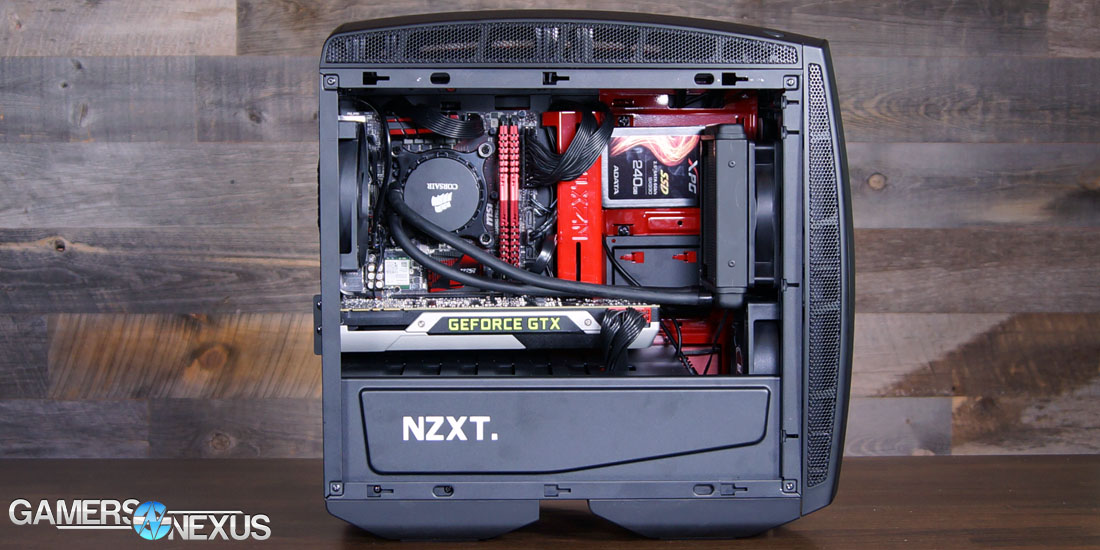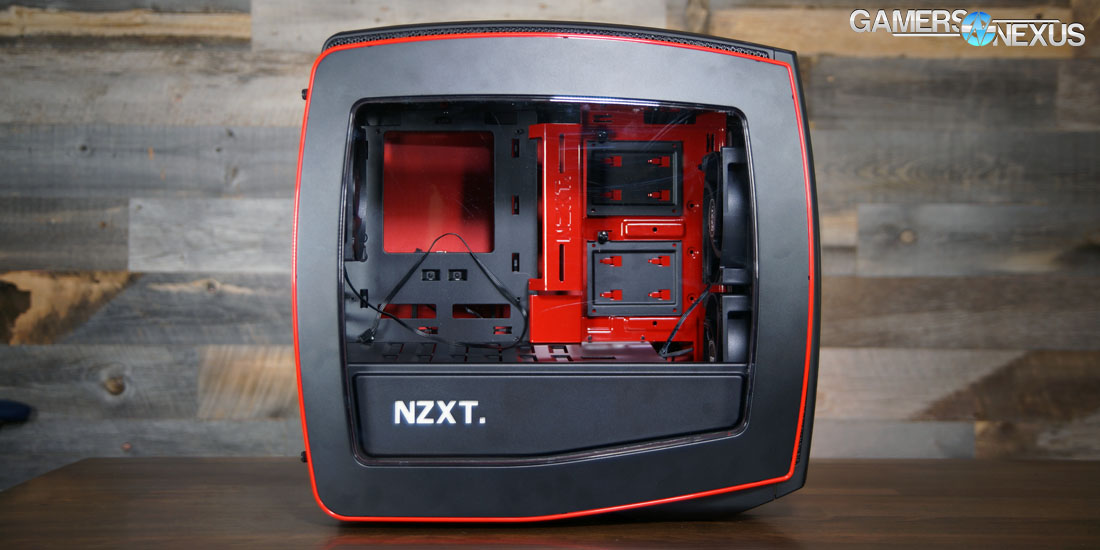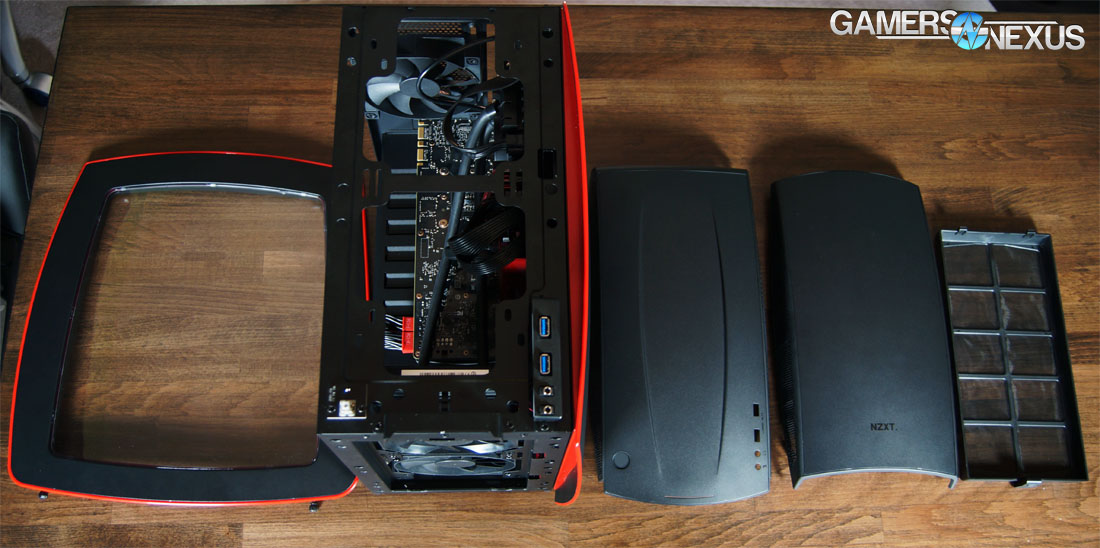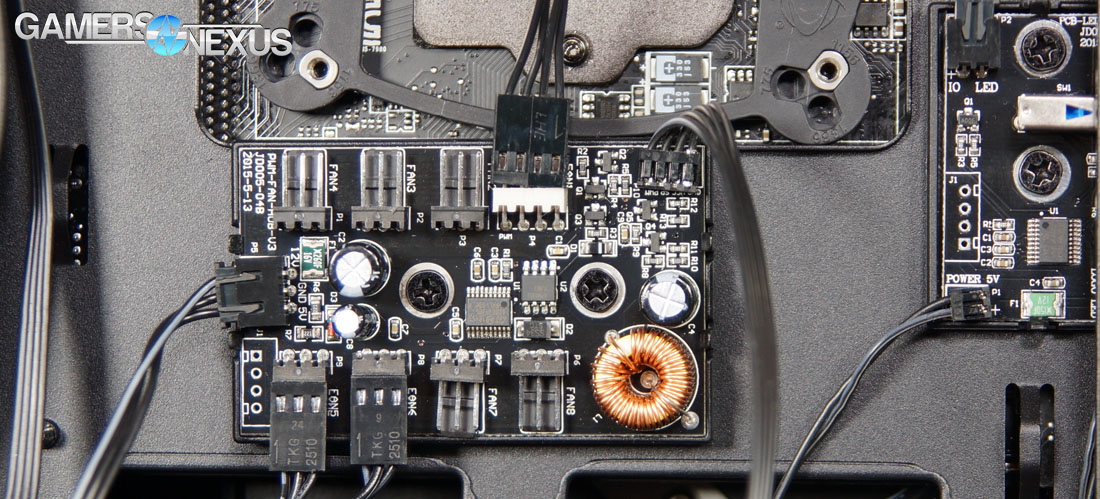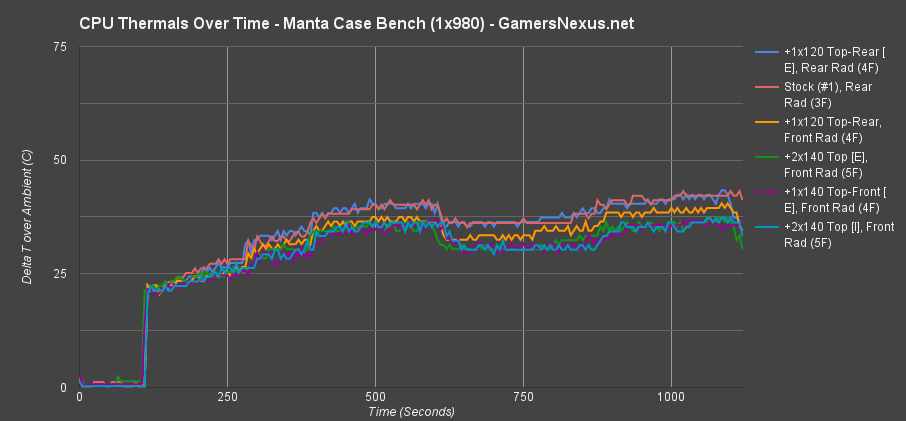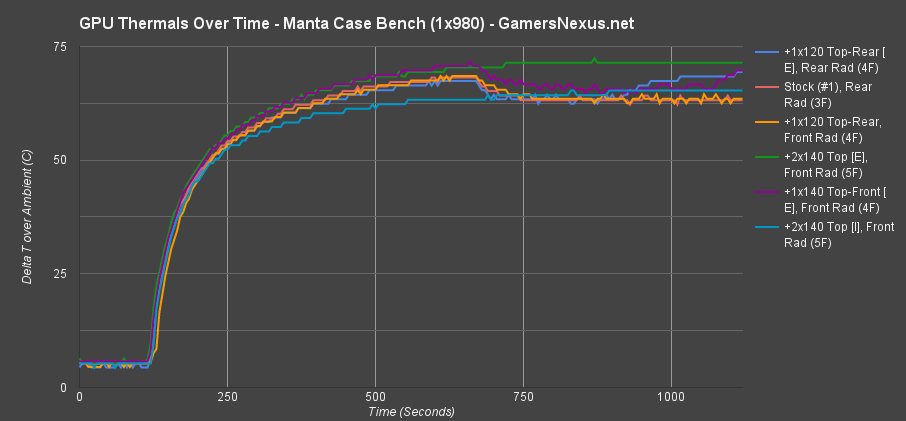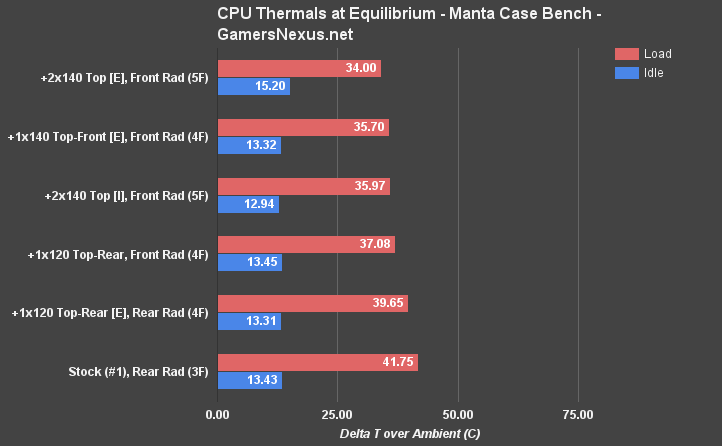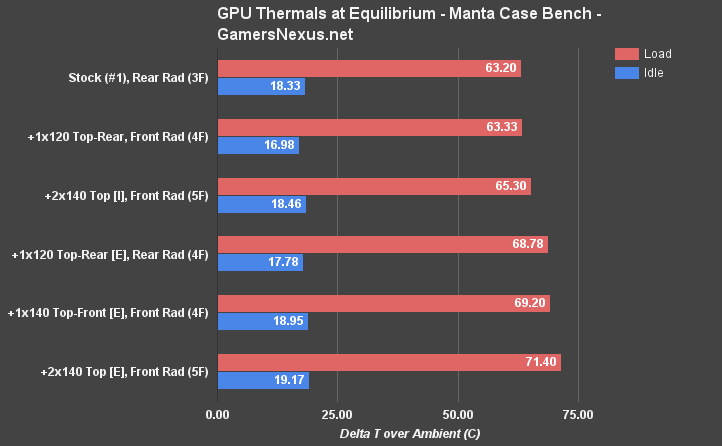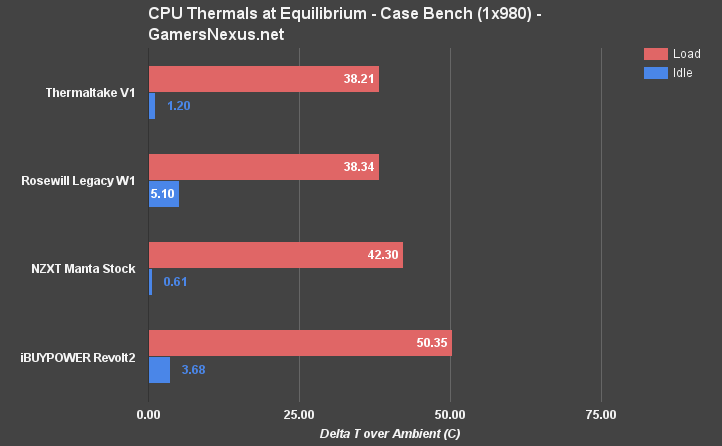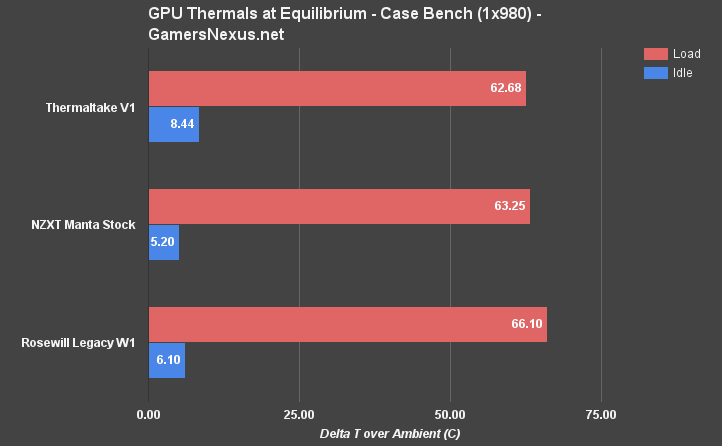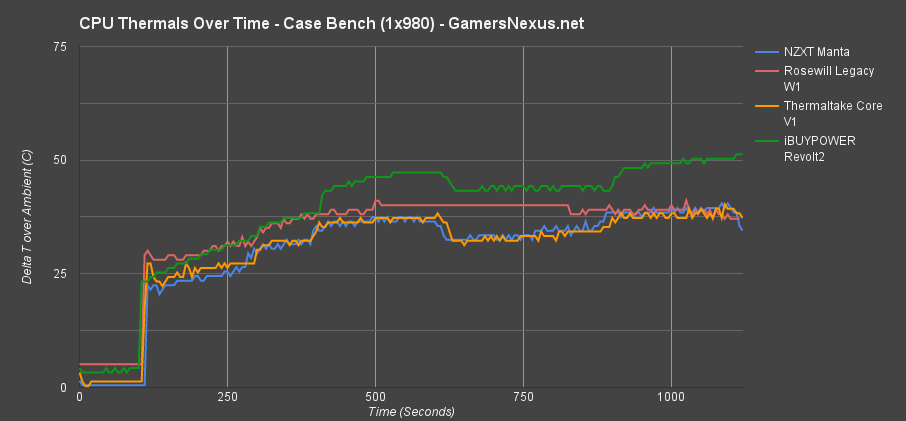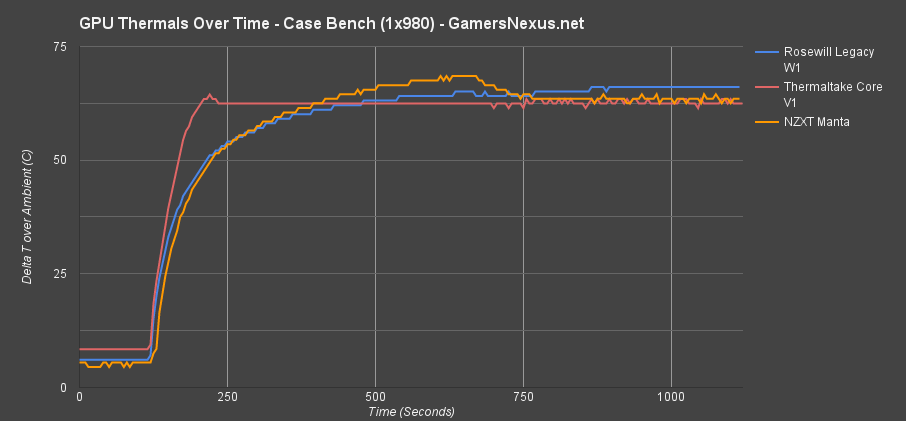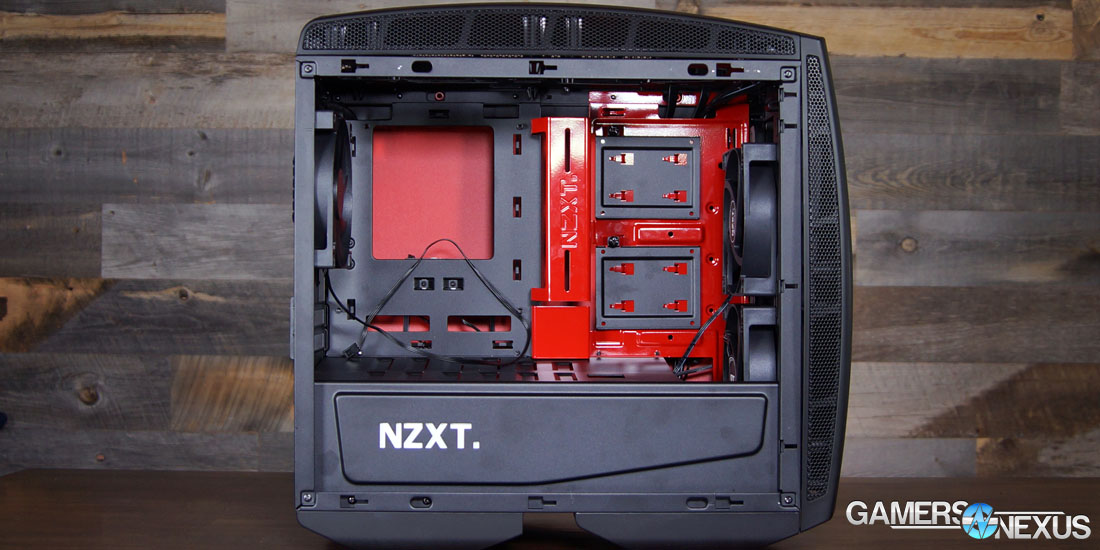Deriving a computer case from a Ferrari 458 seems like a bit of a stretch – but everyone's got to have an origin story, and that's where NZXT started with its Manta case. A previous tour of NZXT's offices showed us that case designers do, in fact, plaster photos of cars upon the office walls and leverage the visual prompts in concepting phases. The Manta makes its statement with curved, stamped paneling made of all steel, creating somewhat of a 'bubbled' look to the enclosure.
The mini-ITX case is NZXT's first venture into sub-ATX form factors since the Vulcan, but keeps to a familiar “tower” form factor that we're calling “Full-Size ITX.” It's not the shoebox form factor that ITX system builders may be used to and feels like a slightly distant cousin to the S340 ($70). In this NZXT Manta ($140) review, we run in-depth cooling benchmarks for a gaming system, analyze build quality, and determine overall value vs. other market contenders.
NZXT Manta Video Review
NZXT Manta Case Specs
| Form Factor | Mini-Tower |
| Motherboard Support | Full-Size ITX |
| Front I/O | 2x USB3.0 1x 3.5mm |
| Cooling | Included: Front: 2x 120mm Rear: 1x 120mm Optional: Top: 2x 140/120mm Front: Replace w/ 2x140mm |
| Radiator Support | Top: Up to 280mm Front: Up to 280mm Rear: Up to 120mm |
| Bays & Expansion | 2x 3.5” 3x 2.5” 2x Expansion slots |
| Clearances | CPU Cooler: 160mm GPU/VGA: 363mm PSU: 363mm |
| Dimensions | 245mm x 426mm x 450mm (WHD) 9.65” x 16.77” x 17.72” 7.2kg / 15.87lbs. |
| Materials & Colors | Steel-plated shell Steel chassis Black, White, Red/Black |
| Price | $140 |
NZXT Manta Layout Walkthrough
The Manta's curves are its most noticeable feature. We've looked at the case on-and-off through its two-year development life-cycle, most recently at CES, and the exterior has slowly grown on us. NZXT Case Designer Shin Feng has worked to create a fusion of “old NZXT” and “new NZXT” design aesthetics, merging the old, all-plastic look and the new, all-steel look. In this regard, NZXT sees the Manta as somewhat of a microcosm for the company's case design history.
But, as our regulars know, subjective matters aren't where we focus – the photos and video will tell that story. We're more interested in the build quality and cooling performance.
The case is almost entirely made of steel, with a few plastic inlays supporting the hardened shell – and it is very much like a turtle shell: Sturdy, surprisingly heavy for the form factor, and inflexible. To our knowledge, this is the first time that curved, stamped, steel paneling has been used in a DIY PC case. Not that being first to curve a panel is particularly impressive; it's just uncommon and a bit of a risk. That willingness to take risks is what drove NZXT to remove optical drives from its H440, though, and that's one of the best-selling enthusiast cases in recent years.
Looking inside the outward-bowed window, we see an interior that resembles a shrunken version of the S340. It's got the PSU shroud, cable management bar, and cleared front for airflow and minimalism. The SSD sleds have been moved off of the PSU shroud and immediately east of the cable management bar, a move that damages the case's ease-of-installation as much as it benefits it. We'll talk about that in the next section.
Cable management cut-outs exist in all the usual places. The only location of note is the cut-out in the PSU shroud, which allows straight-shot PCI-e wiring to the GPU. Two EPS 12V CPU power cut-outs are present, helping further in direct-path wiring. As with the S340, a cable management bar is used for concealment and routing of 24-pin, SATA, and other system headers.
Stock cooling includes 2x 120mm front intake fans – which breathe through bubbled-out meshing on the sides of the front panel (and the underside) – and 1x 120mm rear exhaust fan. Options for 2x 140mm/120mm top fans are present. Radiator support is available for up to 2x 280mm radiators (top/front) and 1x 120mm rear radiator.
A CPU cooler height clearance of 160mm, achievable with thanks to the bowed-out side panel, means most air coolers will fit. T40 units from multiple manufacturers often fall within this height, as do SilverStone's new air coolers.
NZXT Manta Ease-of-Installation & Build Quality
Because the Manta takes the existing mid-tower form factor and shrinks it, installation is identical to what you'd experience with any other shroud-equipped case. The PSU mounts in a separate compartment, as is the new trend in cases, at which point the cables are routed along a concealing cable management bar. The panels are exceedingly easy to remove and, unlike some other cases we've worked with lately, don't send plastic shards flying immediately upon unclipping the paneling.
GPU configurations are naturally limited to single-GPU setups, since mini-ITX cases don't even offer multiple PCIe slots, anyway. The card is pressed right up against the PSU shroud, a fact that will benefit some cooler designs more than others (large push fans would work well).
Unfortunately, NZXT's brand new HUE+ RGB LED controller doesn't fit the window-facing 2.5” SSD sleds, relegating the box to a hackneyed install or 3.5” basement-dwelling. Definitely an oversight.
Test Methodology
We tested using our new mITX test bench, detailed in the table below. We’ve moved from a one-bench-fits-all setup (which uses a Haswell config in an mATX board) to multiple benches, one for mATX and small towers, one for ATX / mid-towers, and one for mini-ITX cases. This bench is for the mini-ITX enclosures.
Conducting thermal tests requires careful measurement of temperatures in the surrounding environment. We control for ambient – which is set to a constant 21C – and then produce charts using a Delta T(emperature) over Ambient value. A laser is used to log the host table's temperature. Thermistors are used to measure true ambient at the intake location. Delta T over Ambient subtracts ambient room temperature from the measured output, producing a delta report of thermals. AIDA64 is used for logging thermals of silicon components, including the GPU diode, CPU package, and PCH.
All case fans are manually configured to their maximum throughput using BIOS. If a fan controller is present, we opt-in and test on multiple settings. This forces testing of case fan performance in addition to the case's air channeling and air-stream design. This also ensures minimal variance when testing, as automatically controlled fan speeds can reduce reliability of benchmarking. The CPU fan is set to use a custom fan curve that was devised in-house after a series of testing; setting the CPU fan to its maximum speed can limit the disparity shown from case-to-case as the CPU cooler is extremely efficient, and will create a ceiling for thermal performance if bottlenecked.
| Component | Part | Cost |
| CPU | Intel Core i7-6700K | $400 |
| Memory | 16GB ADATA XPG DDR4-2400 | $100 |
| Motherboard | MSI Z170I Gaming Pro AC | $170 |
| Video Card | NVIDIA GTX 980 Ti Ref | $650 |
| Cooler | Corsair H55 | $60 |
| PSU | 750W Gold Thermaltake | $100 |
Additional thermal testing was conducted for the NZXT Manta case – something we're continuing going forward (the 400C is next) – for determining the best possible fan configuration. The following matrix was engineered for positional testing of radiators and case fans in the Manta.
| Front | Top BACK | Top FRONT | Rear | Total Fan # | |
| Stock - +1 Rear Rad | 2x 120 intake | 1x 120 exhaust | 0 | 1x 120 W/RAD Push | 4 |
| Stock - Rear Replace | 2x 120 intake | 0 | 0 | 1x 120 W/RAD Push | 3 |
| Stock - +1 Top Rad | 2x 120 intake | 1x 120 W/RAD Push | 0 | 1x 120 exhaust | 4 |
| Stock - Rear Replace Raised Front Fans | 2x 120 intake | 0 | 0 | 1x 120 W/RAD Push | 3 |
| Front Radiator | 1x 120 intake 1x 120 W/RAD (front-top) Push | 1x 120 exhaust | 0 | 1x 120 exhaust | 4 |
| Add 2x 140mm Front Radiator | 1x 120 intake 1x 120 W/RAD (front-top) Push | 1x 140mm exhaust | 1x 140mm exhaust | 1x 120 exhaust | 5 |
| Add 1x 140mm Front Radiator | 1x 120 intake 1x 120 W/RAD (front-top) Push | 0 | 1x 140mm exhaust | 1x 120 exhaust | 4 |
| Add 2x 140mm Rear Radiator | 2x 120 intake | 1x 140mm intake | 1x 140mm intake | 1x 120 W/RAD Push | 5 |
Our objective was to figure out the optimal number and orientation of case fans in the Manta. We tested radiator location (rear-mount vs. front-mount), intake vs. exhaust configurations in the top fan slots, and even tested height adjustment for the front fans. We'll discuss that more later. Another objective of testing was to determine the ideal CPU radiator mounting position when considering GPU thermals. A radiator as front intake will obviously push heat into the case, for which we perform comparative analysis of CPU thermal reduction against GPU thermal increase. Finally, we aim to locate the best possible location to add one extra fan; in other words, if you were to purchase one fan for the case, we figure out where it'd best fit.
The video card is configured to run at 55% fan speed at all times. Stock clocks are used. We employ an NVIDIA GTX 980 Ti reference for the case test bench.
Prior to load testing, we collect idle temperature results for ten minutes to determine the unloaded cooling performance of a case's fans and air channels. Thermal benchmarking is conducted for twenty minutes, a period we've determined sufficient for achieving equilibrium. The over-time data is aggregated and will occasionally be compiled into charts, if interesting or relevant. The equilibrium performance is averaged to create the below charts.
Load testing is conducted using Prime95 LFFTs and Kombustor “Titan Lake” stress testing simultaneously. Testing is completely automated using in-house scripting, and executes with perfect accuracy on every run.
Cases Tested
| Case | Configuration | Price |
| NZXT Manta | Stock 2x 120mm front intake 1x 120mm rear exhaust Additional Configurations (See above table) | $140 |
| Thermaltake Core V1 | Stock 1x200m front intake | $50 |
| Rosewill Legacy W1 | Stock 1x 140mm Front Intake 1x 140mm Rear Exhaust | Not Available |
| iBUYPOWER Revolt2 | Stock 1x 120mm Bottom Intake | Not Available Separately |
Note: No Objective dBA Analysis At This Time
We’ve said this a few times, but it’s worth repeating: We do not presently test for noise emissions / decibel levels on products. It’s something we’re passively exploring, but dBA testing is not trivial, requires a stable environment with a known noise floor, and requires expensive equipment and training. We may be able to sort out the math and the methodology, but there’s still that environment limitation.
Our approach to methodology is underscored by one point: If we can’t do it consistently and confidently, we don’t do it at all. For noise, we aren’t yet confident in a reliable methodology given our setup, so we don’t test noise. Subjectively, we can state that the NZXT Manta enclosure is noticeably quieter than some of its more mesh-laden competitors, resultant of a reliance upon thick steel paneling and limited mesh placement.
Continue to the next (and final) page for thermal benchmark charts and optimal fan configuration analysis.
NZXT Manta Thermals over Time Benchmark – Optimal Fan Configuration
These first charts show thermals over time, including a pre-buffer idle period of two minutes and the following burn-in. The first set of charts looks specifically at various NZXT Manta configurations. After these, we'll move to comparative analysis against the Thermaltake Core V1, Rosewill Legacy W1, and iBUYPOWER Revolt2.
Let's reproduce that test matrix from page 1. The below matrix shows our various test configurations executed:
| Front | Top BACK | Top FRONT | Rear | Total Fan # | |
| Stock - +1 Rear Rad | 2x 120 intake | 1x 120 exhaust | 0 | 1x 120 W/RAD Push | 4 |
| Stock - Rear Replace | 2x 120 intake | 0 | 0 | 1x 120 W/RAD Push | 3 |
| Stock - +1 Top Rad | 2x 120 intake | 1x 120 W/RAD Push | 0 | 1x 120 exhaust | 4 |
| Stock - Rear Replace Raised Front Fans | 2x 120 intake | 0 | 0 | 1x 120 W/RAD Push | 3 |
| Front Radiator | 1x 120 intake 1x 120 W/RAD (front-top) Push | 1x 120 exhaust | 0 | 1x 120 exhaust | 4 |
| Add 2x 140mm Front Radiator | 1x 120 intake 1x 120 W/RAD (front-top) Push | 1x 140mm exhaust | 1x 140mm exhaust | 1x 120 exhaust | 5 |
| Add 1x 140mm Front Radiator | 1x 120 intake 1x 120 W/RAD (front-top) Push | 0 | 1x 140mm exhaust | 1x 120 exhaust | 4 |
| Add 2x 140mm Rear Radiator | 2x 120 intake | 1x 140mm intake | 1x 140mm intake | 1x 120 W/RAD Push | 5 |
For these charts, [E] denotes exhaust, [I] denotes intake, and #F (e.g. 4F, 5F) denotes total fan count.
And now, a pair of charts:
The above charts show thermals over time – a bit harder to read than the equilibrium charts, but useful. It's apparent that the “green” configuration (add two 140mm top fans as exhaust) is the worst possible configuration for GPU cooling. This makes sense, too, since those fans are effectively siphoning cool air away from the internal components faster than it can cool them. This same “green” configuration works reasonably for the CPU because of the front-mounted radiator, a configuration that dominates CPU performance charts for the NZXT Manta. This configuration pushes a bit more warm air into the case, but proper fan configuration will ensure the heated intake doesn't negatively impact the GPU. This configuration is not “proper,” as the triple-exhaust setup ensures all the air gets pulled ever upward and out – not ideal for a blower-style GPU fan.
The lighter blue configuration isn't ideal, either, and it's for the same reason: An exhaust fan positioned in the top-rear is pulling air away from other components. In this configuration, we also had the radiator rear-mounted, and so a top-rear exhaust fan is siphoning cool air away from the CLC before it ever reaches the radiator. In this way, the top-rear fan is parasitic in nature and detrimental to overall cooling performance. If configuring the system with a rear radiator, we can definitively state that a top-rear exhaust fan is a configuration that is best avoided.
An ideal configuration involves a front-mounted radiator for optimal CPU cooling, but it needs to be mounted in a way that doesn't negatively influence GPU thermals. We recommend installing the front radiator in the front-top location, then leaving the rear 120mm exhaust fan where it was pre-installed. This ensures a clear path-to-exit for the warmed CPU air, but doesn't siphon the bottom intake fan's air from the GPU.
Let's move on to some more legible charts.
NZXT Manta Thermals at Equilibrium – Optimal Fan Configuration
The above charts represent thermals at equilibrium, or once temperatures have ceased their rising pattern and hit a stable number. We've got idle and load metrics available, though the various configurations are generally inconsequential to idle performance (but not always).
This data set is the same as what the thermals-over-time metrics used, just visualized in a different way.
For CPU temperatures, again, the triple-exhaust configuration produces the lowest readings at 34C, though idle is noticeably higher at 15.2C. It does not necessarily follow that the coolest load configuration will produce the coolest idle configuration – this is something we've seen in a few other cases, too. Correlating the triple-exhaust setup to the GPU chart, it becomes apparent that this is, in fact, one of the worst configurations possible. Pushing the GPU into the 71.4C delta T over ambient range means that, factoring-in an assumed ambient of about 20C, we've now got a GPU that is thermally throttling at 90C (absolute temperature). That's one's no good, then.
Conversely, the GPU is coolest with the 3-fan stock setup on the contingency that the radiator is not front-mounted. The 63.2C delta T value is achievable because of two factors: (1) The front intake is unobstructed and does not pass through a radiator; (2) the exhaust is a single-fan setup and not overpowering the blower fan's ability to cool itself. This setup, though, is the worst for the CPU by several degrees.
Strictly looking at the charts, the best mix of CPU & GPU thermals would appear to be produced by the dual 140mm top intake. We've seen this in cases before. The only reason the effect isn't more exaggerated is because of the Manta's solid top panel, which aids in reducing noise emissions, but does trade-off some intake potential (exhaust is less of a concern – it's easier to get rid of air). Unfortunately, this five-fan setup isn't the best value and pulls only slightly ahead of the next configuration's thermal readings.
The best setup is to run +1x120mm top-rear fan and a front radiator. This keeps the GPU temperatures at a superb (for the reference cooler) 63.3C, and only raises the CPU to 37.08C. Not bad at all for either, when considering the case's focus on silence and discretion. Since most radiators include a fan, it's likely that CLC users will be running four fans anyway.
NZXT Manta Thermals at Equilibrium – NZXT Manta vs. Core V1, Others
Time for some cross-brand comparisons.
Thermaltake's Core V1 is the best with both CPU and GPU thermals, producing 38.21C CPU temperatures against the Manta's 42.3C. The Legacy is only slightly warmer than the V1, but sits at significantly higher idle temperatures with a 5.10C read-out. The differences between these three cases are mostly inconsequential in the real-world. It's not until we get to the Revolt 2 that more measurable differences emerge, but that's something which we'll discuss in the Revolt2 review.
The GPU temperatures for the V1 are at 62.68C load and run pretty warm idle, with an 8.44C reading. The idle read-out is warmer than the others because thermaltake relies upon the GPU to pull its own air, as it's slightly to the side of the intake fan. The Manta sits at 63.25C load, which really isn't bad for a small case with a focus on silence.
NZXT Manta Thermals over Time Benchmark vs. Core V1, Others
Conclusion: Best-in-Class Build Quality, but Odd Market Segment
NZXT's Manta is peculiarly positioned within the mini-ITX market. It's not as small as a shoebox case, not as large as the company's own dominating mid-tower, and yet it's not suited for anything other than an ITX build. For users seeking absolute discretion for home-theater gaming PCs, the Manta may be too large and “present.” For users seeking a literal desktop PC, the S340 and Fractal Define cases often fit the bill and can be fitted with more drives, ATX form factor boards, and are ~$70 cheaper. That leaves, then, an odd niche of system builders who exist in the space between. Minimalists who want clean, aesthetically-focused room layouts seem the target audience.
$140 is a steep buy. Other mini-ITX boxes have run more expensive – the aforementioned SG08 used to be nearly $200 (with SFX PSU, a requirement) – and the price isn't unfair, it's just entering “enthusiast” territory. That further narrows the market. The thick steel and custom tooling are the primary contributors to the cost. Owners will lay claim to a uniquely shaped PC enclosure that is a love-or-hate item. We won't comment too much on the shape – that's up to you – but speaking to paint quality, it's clear that NZXT has taken past complaints to heart. The Manta has a resilient, beautiful paint job in the red-on-black SKU that we reviewed.
Overlooking HUE+ compatibility seems a bit silly. Thankfully, this is somewhat worked around by using zip ties to mount the controller elsewhere (or by mounting in the bottom of the case), but that doesn't make such an oversight excusable. NZXT should also know better about thumbscrews at this point, an issue that, although petty, is increasingly frustrating with time.
These are issues that are either small or can be worked-around. The Manta on the whole is an exceptionally easy case to build in, offers reasonable thermal performance, and offers top-class build quality. Build quality is worth the most attention: NZXT's thick, steel paneling and sturdy mounting points makes for a stout and strong enclosure; the front and top panels can be removed without instant destruction of mounting clips, unlike some competing products, and that makes radiator installation easier. 280mm radiator support is fairly unique to the ITX market and further attempts to define the Manta in its own class of “Full-Size ITX” cases.
How big that market segment is, I'm unsure. Between “Shoebox” and “Mid-Tower” is an odd place to live. The build quality is there, the thermals are acceptable, and the look is unique enough that it'll be the deciding factor for most would-be buyers. Now it's just a matter of seeing if the market takes the case.
The NZXT Manta mITX case will ship on February 9, 2016.
Editorial & Test Lead: Steve “Lelldorianx” Burke
Test Technician: Patrick “Mocalcium” Stone
Test Technician: Mike “Budekai” Gaglione
B-Roll & Film: Keegan “HornetSting” Gallick
